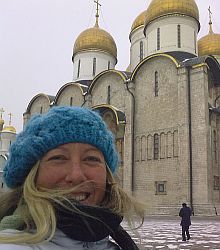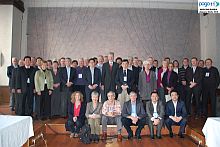POGO Meeting highlights importance of maintaining long-term monitoring
|
Dr Juliet Hermes, Manager of SAEON’s Egagasini Node for Marine-Offshore Systems, attended the annual POGO (Partnership for Observation of the Global Ocean) Meeting which was held in Moscow, Russia.
POGO is a partnership representing the leading laboratories of the world engaged in ocean observations. The annual meetings are held to co-ordinate observations and improve communication. POGO is the lead organisation for ocean observations in GEO, the Group on Earth Observations.
The South African consortium for POGO consists of SAEON, the Ma-Re Institute, and ACCESS (Africa Centre for Climate and Earth Systems Science). This year, Dr Hermes attended the annual meeting on behalf of the South African Consortium.
"POGO is a key international organisation and involvement in POGO allows South Africa access to different bursary options, training and international visiting scientists,” Dr Hermes says. From the meeting, South Africa will also be party to decisions on the latest technology, communications and networking involved in Global Ocean Observations. This is crucial both for South African Operational Oceanography (in which SAEON is involved) and for the Global Ocean Observing System Africa (GOOS-Africa) in which South Africa plays a lead role.
Dr Hermes says that travelling to Moscow during one of the coldest winters in over 60 years was certainly an experience, as was sitting around a table with over 20 directors and deputy directors from the world’s leading oceanographic institutes (NOAA, BAS, PML, SOCS, CSIRO to name a few). “The Meeting provided an opportunity to gain a better understanding of how POGO works, how the different organisations interact and what their future plans are, as well as different opportunities and issues,” she explains.
On arrival delegates were taken on a tour of the Shirshov Institute for Oceanography where they were able to gain an understanding of the work being done there and, with over 1 200 employees and five research vessels there is a lot being done, Dr Hermes says, adding: “Interestingly one of their key displays consisted of a preserved African coelacanth (link to Elwandle article), so I felt at home!"
Results from longest running monitoring stations
Following from this there were numerous presentations dealing with infrastructure for ocean observatories, and results from some of the longest running monitoring stations were given, which included the BATS (Bermuda Atlantic Time-Series Station) in Bermuda. The Director of BIOS (Bermuda Institute of Ocean Sciences), Tony Knapp also discussed the ocean sites’ Google Earth website (jcommops), which has its own data system, and led a discussion on the fact that there are many data repositories in the world but that these were unfortunately not linked. The IOC (Intergovernmental Oceanographic Commission) ocean data portal (IODE webpage) provides access to various datasets.
Einar Svendsen, Director of the Bergen Institute of Marine Research discussed the sad reality that after 60 years, Station M off Norway will no longer receive funding. Although, where possible, ship measurements will still be taken in this region, this led to an interesting discussion of how different institutes who may be working in the area can help improve the temporal coverage. The discussion highlighted the importance of maintaining long-term monitoring.
Cyber-infrastructure to create an interactive ocean laboratory
Susan Avery from the Woods Hole Oceanographic Institute discussed the Ocean Observatories Initiative, which consists of an array of different sensors (physical, biological, engineering, etc) throughout the water column and uses cyber-infrastructure to create an interactive ocean laboratory. There are cruises to the four global sites every 12 months (see www.oceanleadership.org and http://oceanobservatories.org).
There was also a presentation on the POGO ships database, which is a website showing activities by all the institutes. South Africa will soon be supplying information to the website.
The Census of Marine Life gave a presentation on a potential ‘quiet ocean experiment’ - dedicating one day when all noise in the ocean is stopped and acoustic measurements are made. This day is only being proposed in a few years’ time as initial feasibility studies need to be completed first.
An interesting presentation and discussion on core observations and rationalising committees raised the fact that there are over 400 acronyms that are related to ocean sciences!
Delegates had the opportunity to visit the Russian Academy of Sciences. Dr Hermes describes the walk there in -20 degrees and in snow as "invigorating”. Delegates were rewarded for their efforts with the premiere of the movie Océans, produced in partnership with the Census of Marine Life and the Sloan Foundation. This movie will soon be in cinemas and available on DVD (http://www.coml.org/oc%C3%A9ans-film or http://www.oceans-lefilm.com/).
The next POGO meeting will be held in Korea in 2012. The South African delegation put forward a bid to hold the 2013 meeting in Cape Town, which was well received.
If anyone would like more information on the POGO Meeting, or documentation, please contact Dr Juliet Hermes.




